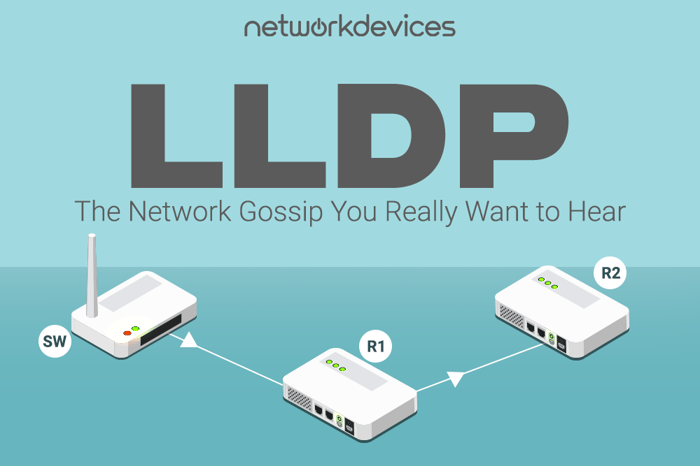You have no items in your shopping cart.

LLDP: The Network Gossip You Really Want to Hear
LLDP, or Link Layer Discovery Protocol, is an essential tool in the evolving threat landscape of network management. Recent cyber-attacks, like the SolarWinds breach and the Colonial Pipeline ransomware attack, have underscored the importance of robust network visibility.
Link Layer Discovery, an IEEE (LLDP-802.1AB) standard protocol, plays a critical role in network device discovery, helping identify and map out all neighboring devices within a LAN or WAN infrastructure. Unlike traditional EPPs, which struggle with limited visibility and outdated mechanisms, LLDP provides a vendor-independent solution that operates over Ethernet frames, ensuring seamless communication within the OSI model. By utilizing MAC Addresses and Ethernet frames, it periodically advertises the presence of devices every 30 seconds, keeping the network topology up-to-date and secure.
The functionality of LLDP and Cisco's CDP (Cisco Discovery Protocol) is the same. The only variation is that DCP is Cisco's proprietary protocol and does not work on non-Cisco devices/platforms. Due to its proprietary dependency, the CDP can only discover the Cisco devices it is connected to.
LLDP Operation Modes and Timers
Link Layer Discovery Protocol operates in different modes and utilizes several timers to manage the discovery and maintenance of network topology information.
Here's a breakdown of these modes and timers:
1. Transmit Only
This mode allows a device to send LLDP packets to advertise its information but does not process or store any packets it receives.
Use Case: Ideal for devices that need to announce their presence without needing to learn about their neighbors.
2. Receive Only
In this mode, a device listens for LLDP packets from other devices and processes them to gather neighbor information but does not send out any packets.
Use Case: Suitable for devices that need to learn about their neighbors without announcing their presence.
3. Transmit and Receive
This mode enables a device to both send and receive LLDP packets, allowing it to advertise its information and learn about its neighbors.
Use Case: Commonly used in most network devices to fully participate in the LLDP-based network topology discovery.
LLDP Timers
Link Layer Discovery Protocol Timer refers to various time intervals that are crucial for the operation and management of the protocol on network devices. These timers control the transmission of LLDP packets as well as the maintenance of the information learned from these packets.
i. Hold Time
The hold timer determines how long a receiving device should maintain the information about a neighbor after receiving an LLDP packet from that neighbor. If the timer expires without receiving a new packet, the neighbor information is considered stale and is discarded. The default value is 120 seconds.
Use Case: Ensures that outdated or lost neighbor information is eventually removed, maintaining an accurate view of the network topology.
ii. LLDP Packet Frequency Timer
This interval dictates how often a device sends out LLDP frames to advertise its information to its neighbors. The default value is 30 seconds.
Use Case: Regularly updates neighboring devices with the latest information, ensuring timely and accurate network topology data.
iii. Reinit Time
The delay period before Link Layer Discovery Protocol initializes on any interface after reconfiguring or resetting. The default value is 2 seconds.
Use Case: Provides a brief delay to allow interface stabilization before it starts, preventing premature or incorrect information from being transmitted during initialization.
These LLDP modes and timers work together to facilitate the discovery and maintenance of network topology information, ensuring devices can effectively communicate their presence and capabilities within the network.
What are the Advantages of using LLDP?
· Vendor-neutral interoperability
This standardized protocol (IEEE 802.1AB) works across different vendors' devices, ensuring seamless communication and information exchange in multi-vendor environments.
· Automatic Network Topology Discovery
Link Layer Discovery Protocol enables automatic discovery of network topology by providing detailed information about each device and its neighbors. This helps network administrators visualize the network layout accurately.
· Simplified Troubleshooting
By providing detailed information about device neighbors, LLDP helps quickly identify network issues such as misconfigurations, incorrect connections, or faulty hardware. This reduces the time required for troubleshooting.
· Enhanced Network Management
This protocol provides critical data such as device identification, port descriptions, VLAN information, and power over Ethernet (PoE) requirements. LLDP data can be seamlessly integrated with network management systems (NMS) for automated monitoring and configuration, providing real-time insights and control over network resources. This integration is particularly valuable for inventory management and efficient use of network resources.
· Improved Network Security
Link Layer Discovery Protocol can assist in detecting unauthorized devices by continuously monitoring and reporting new or unknown devices connected to the network. This enhances network security by enabling prompt action against potential threats.
How LLDP is Useful in Troubleshooting Network Issues?
LLDP operates at the data link layer, enabling devices to exchange hardware and protocol information with neighboring devices. This capability is invaluable for troubleshooting network issues. Gathering detailed device information about connected devices helps network administrators quickly identify and resolve problems.
Devices running this protocol use the TLVs to exchange information about their capabilities and configuration with their neighbors, enabling efficient network management and troubleshooting.
Link Layer Discovery Protocol uses TLVs (Type-Length-Value) structures to share information:
● T - Type: Specifies the type of information being conveyed (e.g., device name, port description).
● L - Length: Indicates the length of the information.
● V - Value: Contains the actual information.
These details are critical for network management and troubleshooting.
How LLDP Aids in Network Troubleshooting
It facilitates network troubleshooting by:
● Identifying Misconfigurations: By revealing the network topology, LLDP helps administrators detect misconfigured devices or incorrect connections.
● Locating Devices: It provides precise details about device locations, making it easier to find and diagnose faulty hardware.
● Verifying Connections: It ensures that devices are connected as expected, verifying the integrity of network links.
● Simplifying Documentation: It automates the collection of network topology information, simplifying network documentation and audits. This is particularly useful for inventory management and ensuring efficient use of network resources.
Scenario-based examples:
Switch Interconnectivity
Scenario: Two switches are not communicating correctly, causing network segments to lose connectivity.
LLDP Role: It can display the neighboring devices connected to each switch, revealing if they are correctly linked and identifying potential misconfigurations or faulty ports.
IP Phone Connectivity Issues
Scenario: An IP phone fails to connect to the network.
LLDP Role: By checking the LLDP information, administrators can verify if the phone is properly recognized by the switch and ensure it is assigned to the correct VLAN, diagnosing issues with power over Ethernet (PoE) or VLAN mismatches.
Configuring LLDP
Show LLDP Information:
Switch# show lldp
Enable LLDP Globally:
Switch(config)# lldp run
Configure LLDP on an Interface
Switch(config)# interface <interface-id>
Switch(config-if)# lldp transmit
Switch(config-if)# lldp receive
List LLDP neighbors:
Switch# show lldp neighbors
List LLDP neighbors with detailed information:
Switch# show lldp neighbors detail
Display LLDP traffic statistics:
Switch# show lldp traffic
The Bottom Line: Why LLDP Matters
In summary, the Link Layer Discovery Protocol is vital to modern network management. It excels at providing detailed visibility into network topology and device connectivity, which is crucial for effective network administration. LLDP's vendor neutrality and automation capabilities streamline operations and enhance troubleshooting efficiency.
While it may not be the centerpiece of Software-Defined Networking (SDN), LLDP supports enhanced automation and flexibility within these environments. LLDP-MED further extends its utility in specialized VoIP and multimedia applications.
Leveraging Link Layer Discovery Protocol configurations and use cases for organizations managing large or complex networks can yield significant operational benefits. Vendor documentation and detailed tutorials are excellent resources for mastering its implementation.
Ultimately, the Link Layer Discovery Protocol is an indispensable tool for network administrators aiming to maintain a well-organized and secure network infrastructure.












